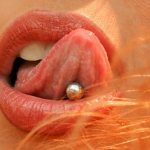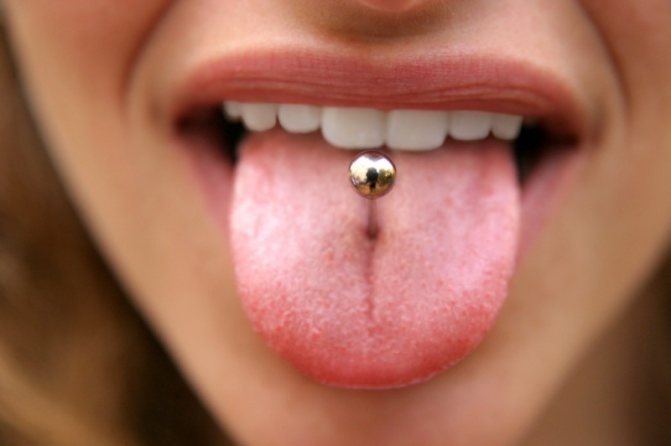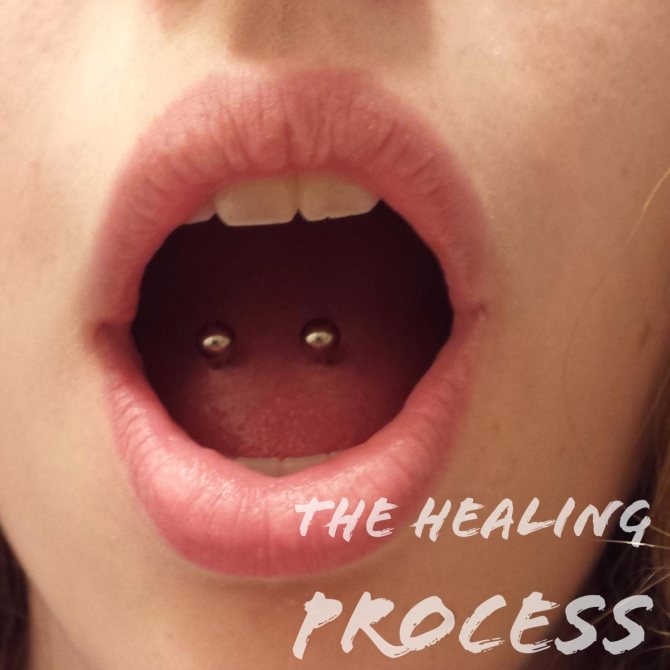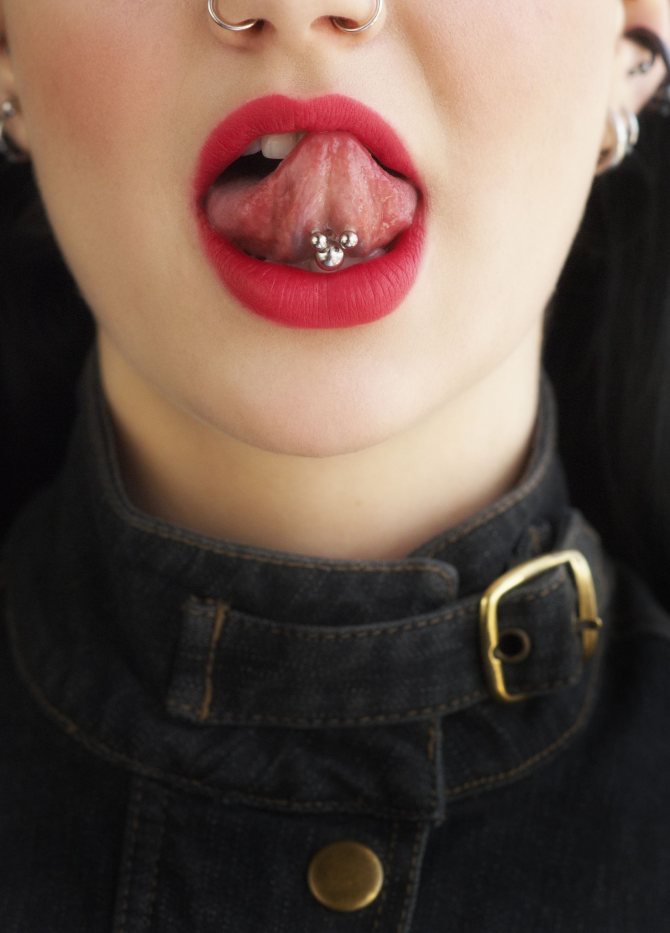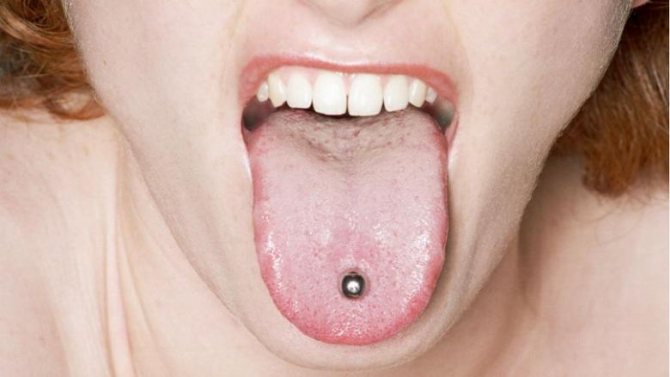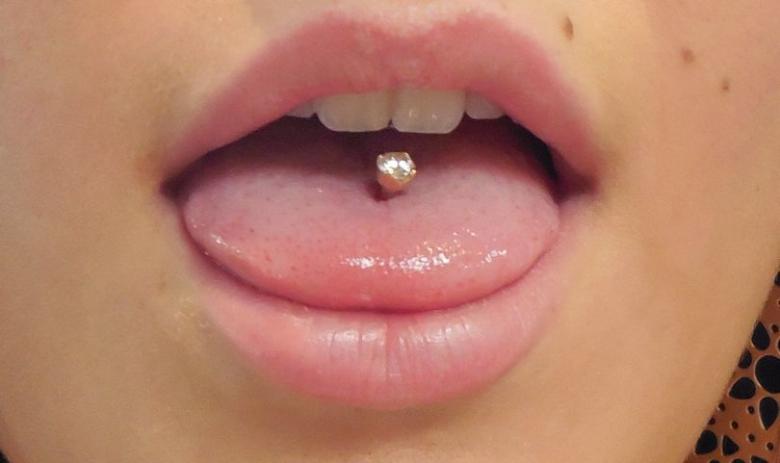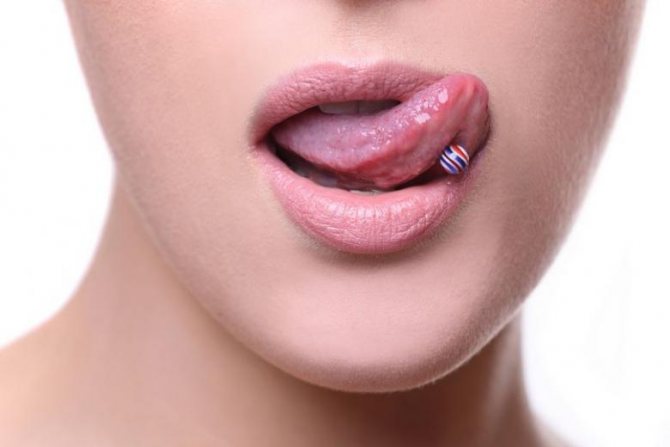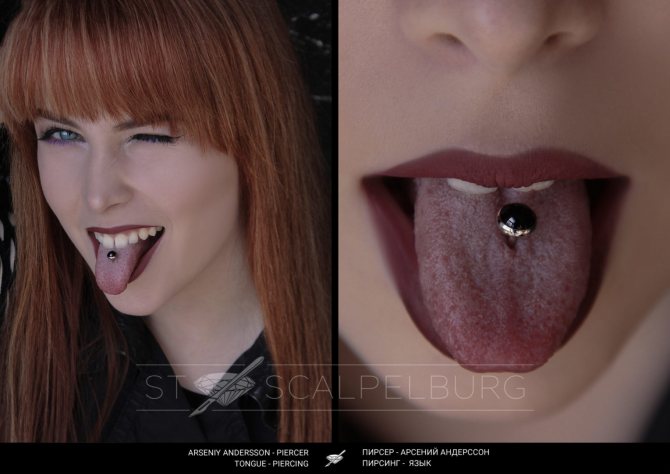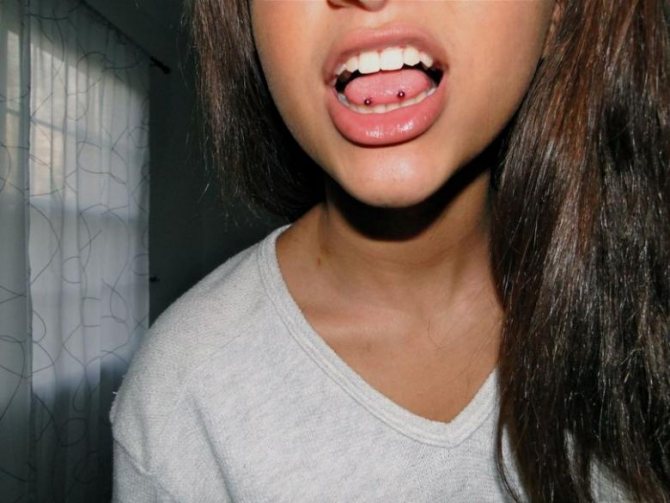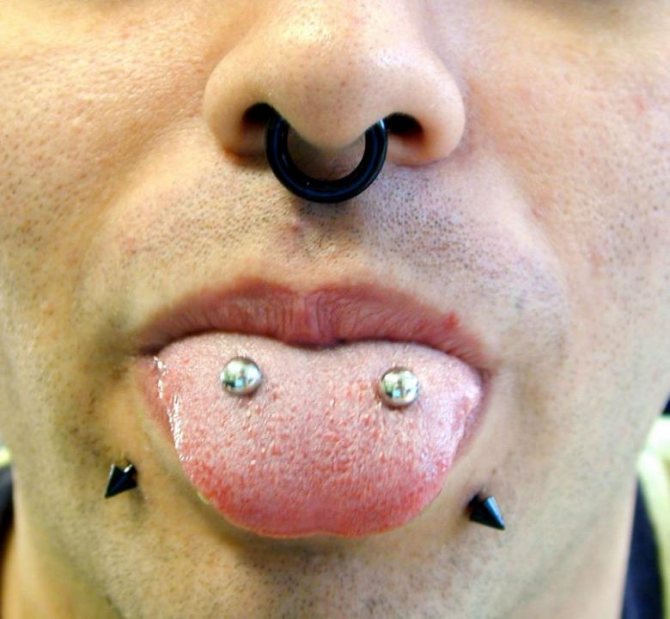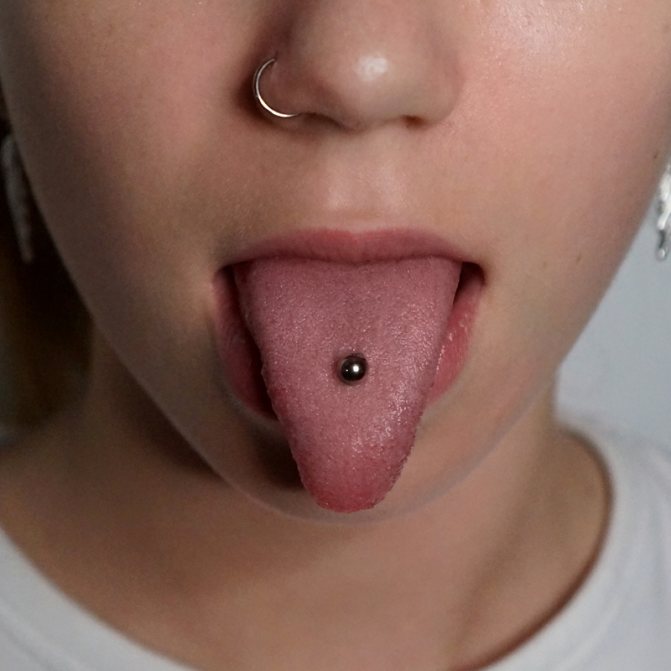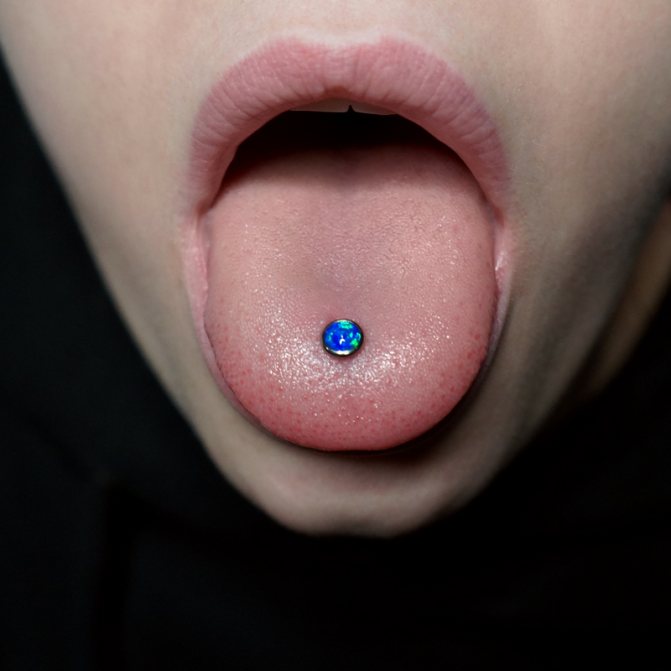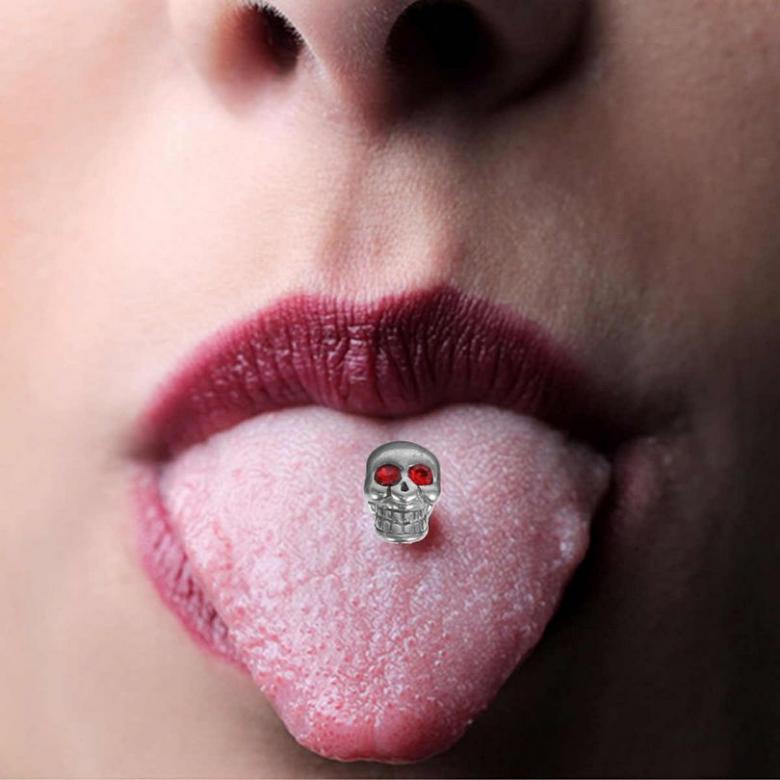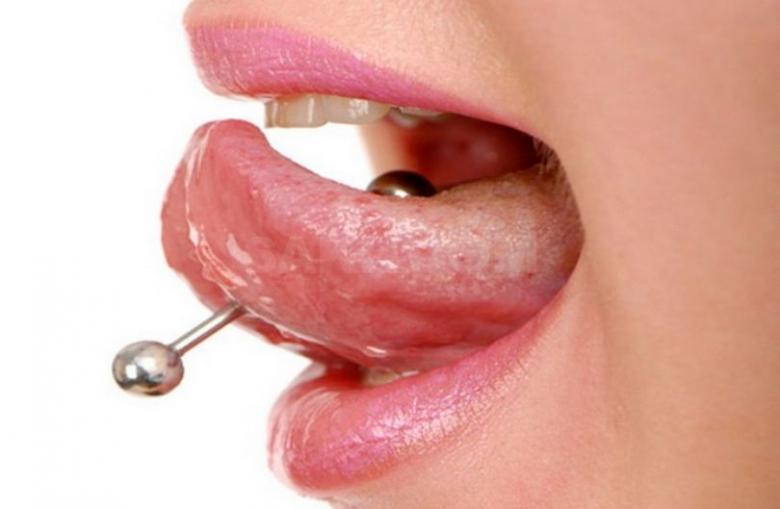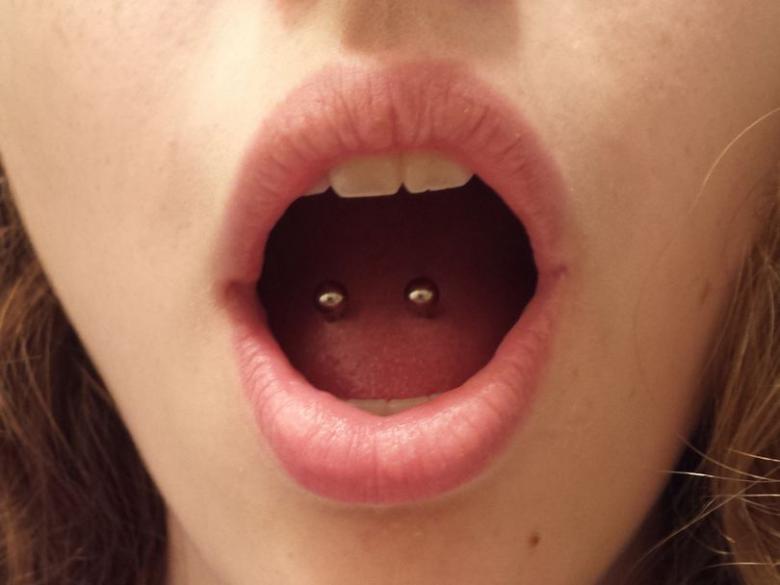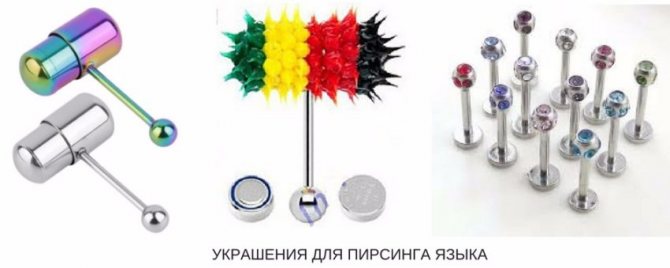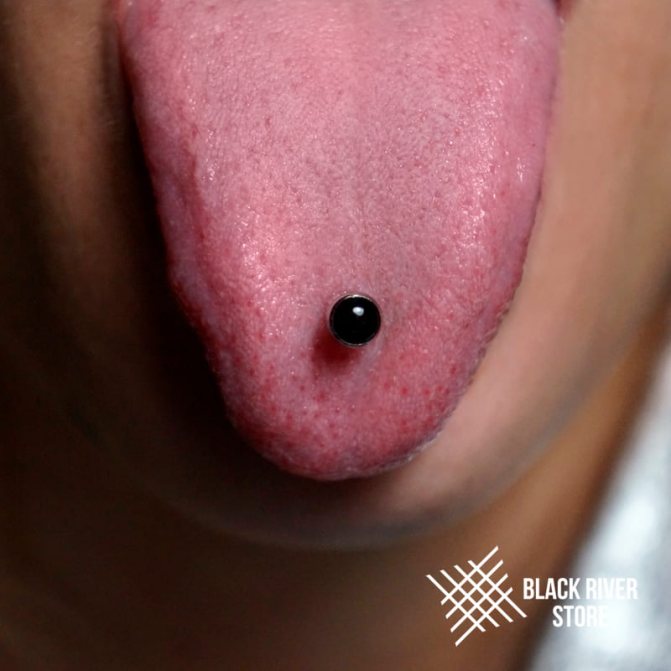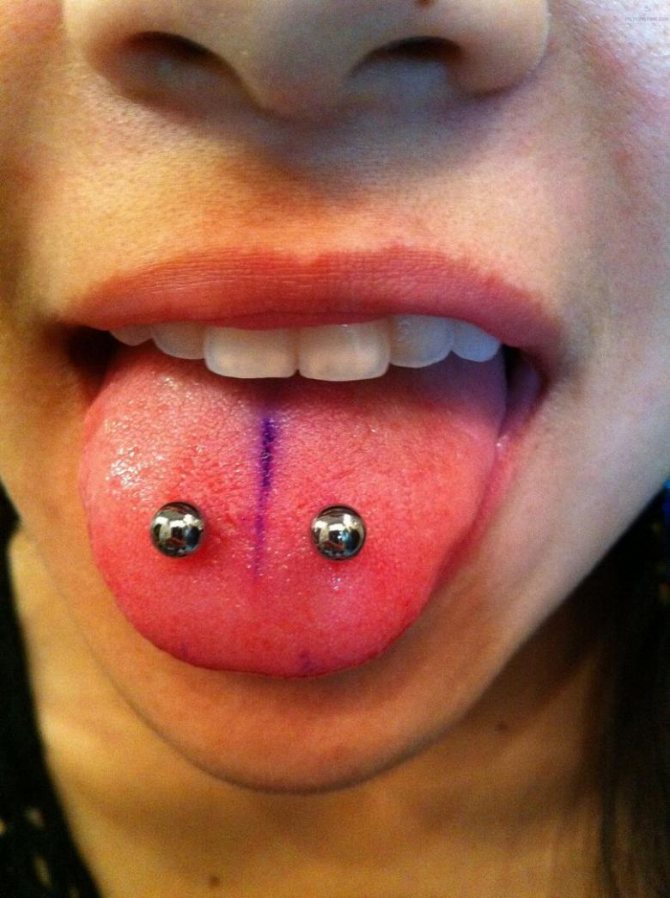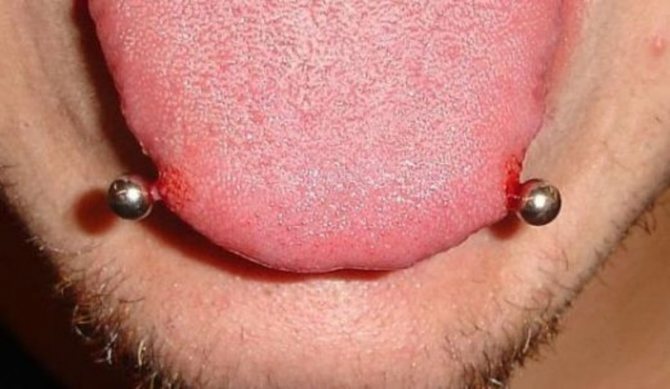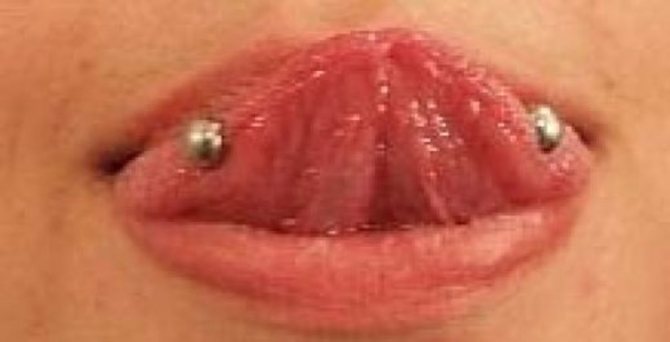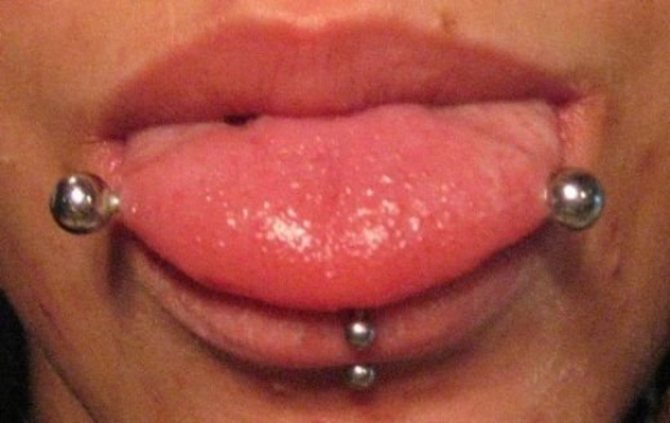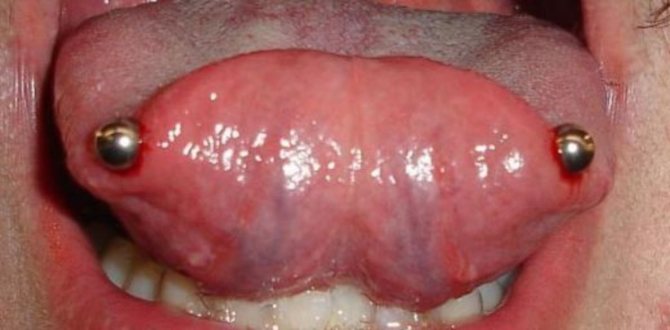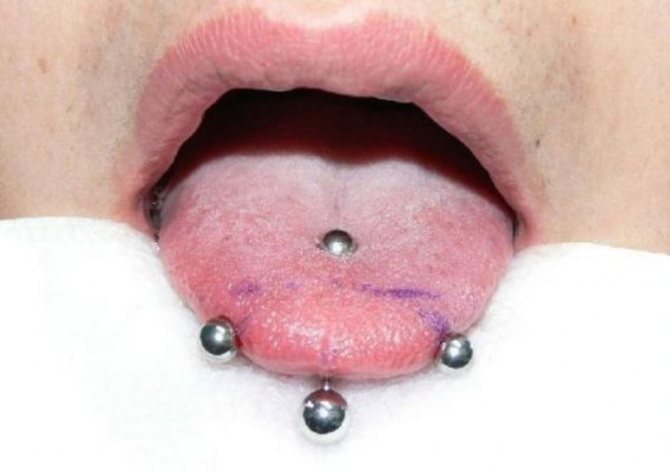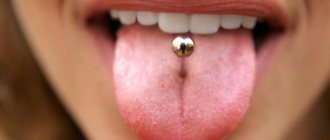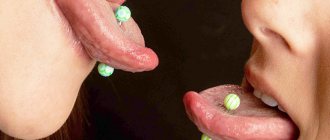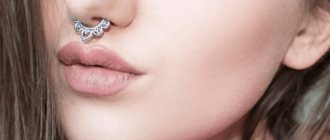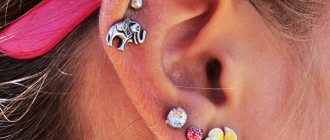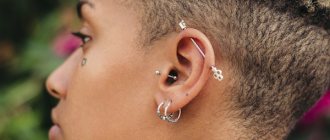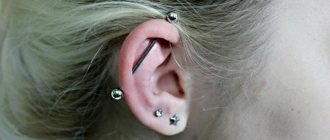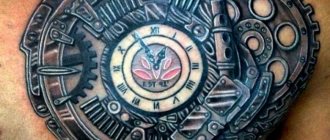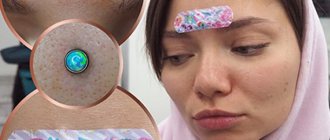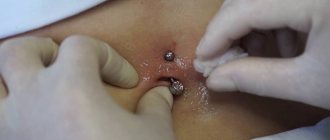Piercing is a rather familiar procedure. It no longer causes strong bewilderment and ugly thoughts in others. But still arguments and curiosities people have when they hear about nipple or genital piercings, as well as tongue piercings. Tongue piercing is done by many people these days. The reasons for this are varied. But before making an important decision and come to the master for tongue piercing, it is necessary to determine whether this operation is necessary and whether it has contraindications.
History of piercings
For the first time the procedure of piercing various parts of the body was practiced by the inhabitants of African tribes and Polynesia. The Maasai were the first to introduce various ornaments in the ears and lips. At that time, it was believed that the larger the size of the jewelry in the body, the greater the "weight" a person has in the tribe.
Belly button piercing first appeared in Egypt. This procedure was very loved by women. The presence of a hole in the navel at the Egyptian woman indicated that she belonged to the "high society".
In Tsarist Russia, sailors preferred to pierce their earlobes and wear a huge earring. Such a "symbol" meant that one had crossed the equator or belonged to the Cossack clan. Later, beginning in the 80s, earlobe piercing became fashionable for rappers.
Nose piercing first appeared in India. The presence of a woman's septum piercing (a pierced septum) indicated marital status, that is, that the girl is married.
Nipple piercing was done by the warriors of ancient Rome. An earring in a man's nipple indicated his masculinity, courage and determination. Only the strongest and bravest warriors had the right to have their nipples pierced. The owners of the earring in the nipple regularly competed with their strength and courage. In order not to damage the "ornament", special cloth capes were worn over the earring.
The ancient Aztecs and North American tribesmen first began to pierce the tongue. They performed the procedure deliberately, as it was considered a magical rite that helped them to reunite with the Gods. The protruding blood on the tongue was considered sacred; it served as a means of appeasing the Spirits.
Nowadays, piercings have an entirely different purpose. By piercing different parts of the body people want to show their individuality, to attract attention or to stand out. For some people, piercings are a way to experience new emotions, to prove to themselves that they can overcome pain and sort of move to a "new level of development".
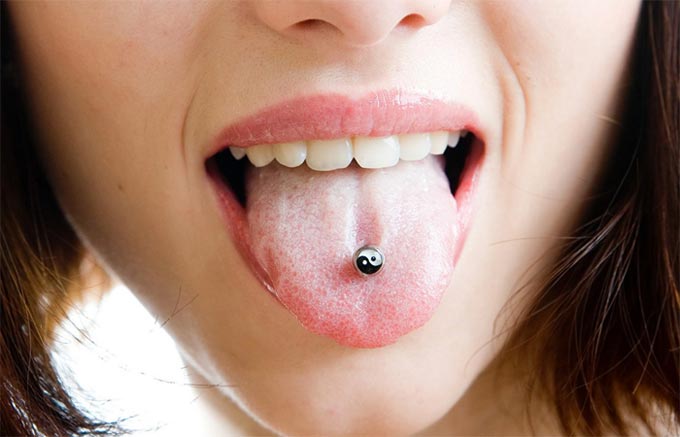
Tongue piercing procedure
Tongue piercing is a surgical procedure. Although it is short-lived, it can be very dangerous to health, and in certain cases to life. The procedure is a sharp puncture of the soft mucosa of the tongue with the further introduction of a special earring or rod.
Among the huge variety of "jewelry" the most common are vertical bars molded from medical titanium or steel. In appearance, the earring turns out to be double, that is, it can be seen from above, and, if you raise the tongue, then also from below.
Another popular type of piercing is the frenulum. This procedure of introducing a frenulum into the tongue is less painless, during the operation, the client is exposed to less blood, and, accordingly, the healing of the wound surface is much faster.
Other "decorations":
- rings;
- carnations;
- staples.
Types of tongue piercings: horizontal, vertical, tongue tip, frenulum under the tongue
The piercing procedure is carried out with a special needle.
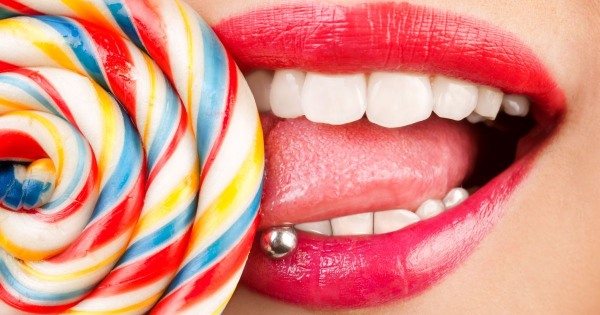

Piercers - professionals who perform the piercing procedure, distinguish between 5 types of tongue piercing:
- HorizontalDuring which the tongue is pierced in the width, from ear to ear.
- VerticalIn which the tongue is pierced from top to bottom, from the palate to the frenulum.
- surfaceThis is the most difficult type of piercing, where the tongue is pierced not through, but along or across the tongue. It is one of the most difficult types of piercings, as the procedure is more complicated than other types, the jewelry may be rejected by the body or it may move from its original place. Before it is performed, the piercer must make sure that the jewelry will not interfere with the movement of the tongue.
- tip, in which the tip of the tongue is pierced. When performing it, it is important to choose the right place for the puncture and the jewelry, because the tip of the tongue is in active contact with the teeth, and the jewelry can cause damage to them.
- FrenulumThe frenulum is a frenulum technique in which the tissue under the tongue is pierced. Although the procedure is easy and virtually painless, over time, the jewel may be rejected. Also, some people cannot have their tongue frenulum pierced because of their anatomy.
Purpose of the piercing
People who decide to have a tongue piercing, pursue different goals. It is a common opinion that the presence of an earring in the soft tissue of the tongue improves sexual satisfaction in the partner. Young girls often decide to have tongue piercings simply to become fashionable. Some people pierce a part of their body in order to show others that they belong to a certain subculture.
Tongue piercing helps people stand out "among the crowd", to indicate that they are not like everyone else, to prove their uniqueness and individuality.
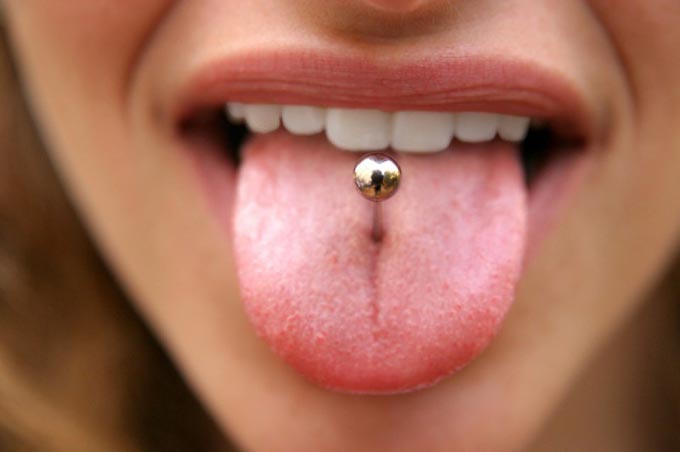

Advantages and disadvantages
The presence of an earring in a person's tongue always draws everyone's attention to it. To the corresponding procedure can be treated both bad and good. But almost always the presence of the piercing arouses the interest of others.
Someone who agrees to the piercing of the tongue feels special, not like everyone else. A person wants to show their individuality in this way. And some people decide to pierce in order to show their determined character or, on the contrary, to overcome themselves.
Advantages of the piercing
- After the procedure, a person begins to consider himself liberated, in his character appears courage and determination. Whoever decides to undergo tongue piercing "challenges" the monotonous and boring life.
- Tongue piercing is not as noticeable to others as, for example, eyebrow piercing. If necessary, the "decoration" can be removed, and no one will notice the presence of the piercing.
- It improves your partner's sexual feelings. When kissing or oral caresses, tongue piercings can give additional sexual excitement, bring a sense of exoticism to sexual intercourse.
- After surgery requires a long recovery period. At this point, it is necessary to follow a strict diet and refuse a long list of products. Such a restriction helps some to lose excess weight.
- If all the basics of proper care are followed, the risk of complications is minimal.
- The possibility at any time to remove the "ornament" and achieve that the tongue piercing is overgrown. Thanks to the active regeneration of soft tissues, the piercing regenerates very quickly.
Disadvantages
- The procedure is very painful. If a person is very sensitive to pain, it will be difficult to endure such an operation.
- The recovery period, which can "stretch" for several months, also brings a lot of inconvenience. The healing process of the wound surface provokes pain and physical discomfort. It can take from 3 to 6 months before all the unpleasant feelings are over.
- Piercing is required to be done only in a specialized clinic or salon, and necessarily by an experienced and qualified master. Many people pierce various parts of the body and do it at home. But in this option, the risk of developing dangerous complications increases dramatically. Saving on your own health can cost much more than the cost of surgery in a proven clinic.
- There is a risk of infection. This often occurs because non-sterile instruments are used during surgery. The development of infection is not the worst complication of piercings. Complications also include hepatitis and herpes. The likelihood of developing dangerous health complications increases many times over if the procedure is performed by inexperienced or unqualified craftsmen.
- Tongue piercings almost always ruin the teeth. This happens because the person has a desire to "chew" or bite the earring. Teeth begin to deteriorate and break for another reason as well - while chewing food, unintentional biting of the metal rod occurs.
- With tongue piercings, careful dental and gum care is required. Many young girls and boys show off their "jewelry" in their mouths to show it off to others who touch the barbell with their hands. All this causes an increase in the number of bacteria and pathogens in the mouth.
- The development of gum disease.
- The presence of a foreign body in the oral cavity often provokes the development of discomfort sensations - redness of the mucosa, itching, the desire to scratch the tongue.
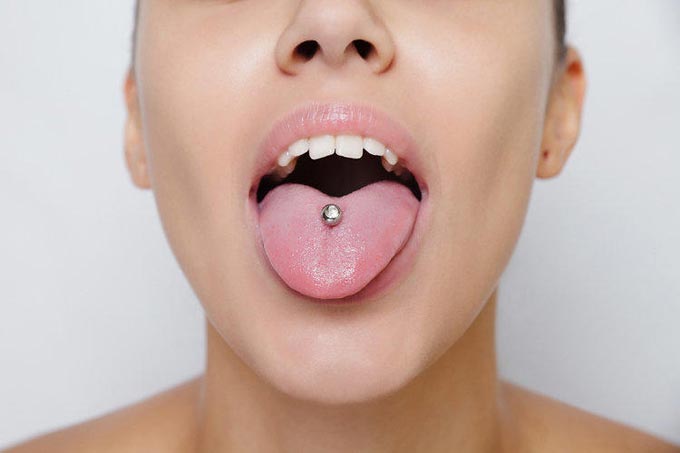

Possible Consequences
The following consequences are likely due to improper care or the work of an unqualified caregiver:
- Risk of contracting HIV, hepatitis C and other dangerous infections;
- An allergic reaction to the materials used;
- Severe bleeding;
- Nerve damage and loss of sensitivity of the organ
- Development of chronic inflammatory gum disease.
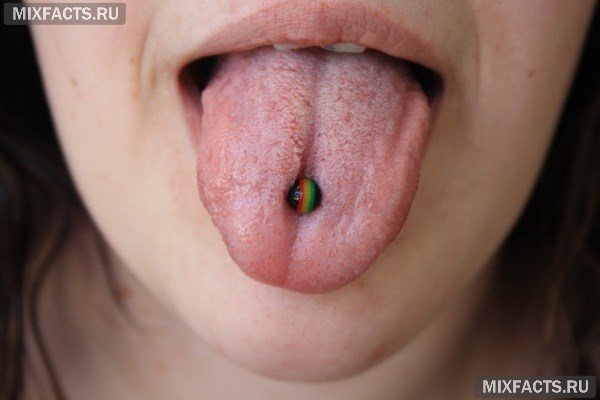

Puncture can cause HIV infection or bleeding
How painful the procedure is
Any surgery is painful. And tongue piercing is no exception. The piercing procedure itself lasts a couple of seconds. The patient feels a sharp, but quite tolerable pain. The main painful sensations begin at the stage of healing of the wound surface. The mucosa of the tongue has high sensitivity, and since this organ of the body is constantly moving, the pain will be excruciating. The discomfort will continue until the wound is healed.
It is possible to reduce the intensity of painful sensations. To do this, you must adhere to the following basics:
- The operation should be performed only in a specialized clinic (salon) by a qualified master;
- During the recovery period, constantly take care of the wound;
- Give up smoking and drinking alcohol-containing beverages (at least for the rehabilitation period);
- try to talk less in the first days after surgery;
- Avoid hot dishes and spicy food.
Piercing procedure
Tongue piercing is an operation. To avoid complications, it is recommended to perform it in a specialized salon. Qualitatively, the procedure can be performed only by a qualified doctor. Only a master is able to determine the optimal place for the piercing, where the risk of traumatization of nerves and blood vessels will be minimal.
During the operation, it is mandatory to use sterile instruments, as well as disposable rubber gloves.
Sequence of action:
- The oral cavity is treated with an antiseptic. In most cases, patients request additional oral anesthesia. Lidocaine solution is used as an anesthetic.
- A special clamp is used to hold the tongue in place.
- A puncture is made on the tongue that is secured with the clamp. The direction of the needle is from bottom to top.
- A metal rod or a "decoration" chosen by the patient is inserted into the hole that is formed.
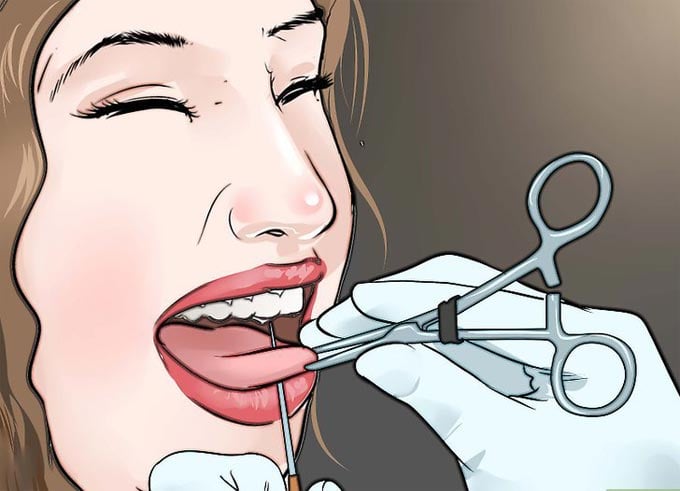

Tongue piercing at home
It is undesirable to do the piercing yourself.
To minimize the risk of complications, the following requirements must be met:
- For the operation, choose a well-lit place. Obligatorily in the room must be present a table on which the necessary tools are spread out.
- Only sterile instruments (clamp, needle, earring) are used for the operation.
- The oral cavity is necessarily treated with a disinfectant solution, and if necessary, irrigated with an anesthetic.
- The part of the tongue closer to the tip is chosen for the puncture site. In this area of the organ there are no large blood vessels.
- The tongue is clamped with forceps.
- A special needle punctures the soft tissue of the organ strictly perpendicular to the surface.
- A barbell is inserted. It is recommended to use a catheter to insert the "decoration".
A catheter is a special device that helps to make piercings at home. Thanks to the catheter, the sensation of piercing the soft tissue of the tongue is less painful.
The catheter is a small needle equipped with a plastic tube. An earring or other "decoration" is inserted into the cavity of the tube. After the puncture, the earring goes into the hole along with the needle. The needle and catheter are then removed, and the "decoration" remains in the inside of the tongue.
What kind of jewelry can be used
Some of the most popular options for tongue embellishments include:
- Classic rods. This is a straight cylindrical shaped rod with decoration on the tips.
- Curved rods. Resemble the shape of a banana.
- Labrets. These are rods that have a disk on one side and a round retainer on the other.
- Rings and earrings. Usually used for placement in the edge and tip of the tongue.
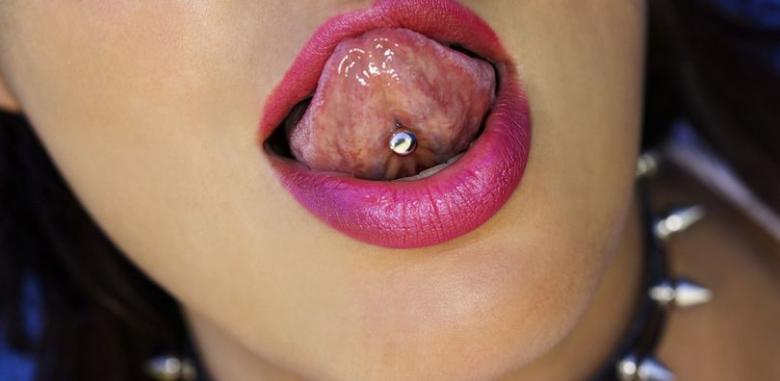

An important criterion is the material of the jewelry. It is better to choose hypoallergenic metals such as gold and silver. Rather versatile and inexpensive solutions are jewelry made of nickel-plated steel, brass. Another good alternative is a titanium rod.
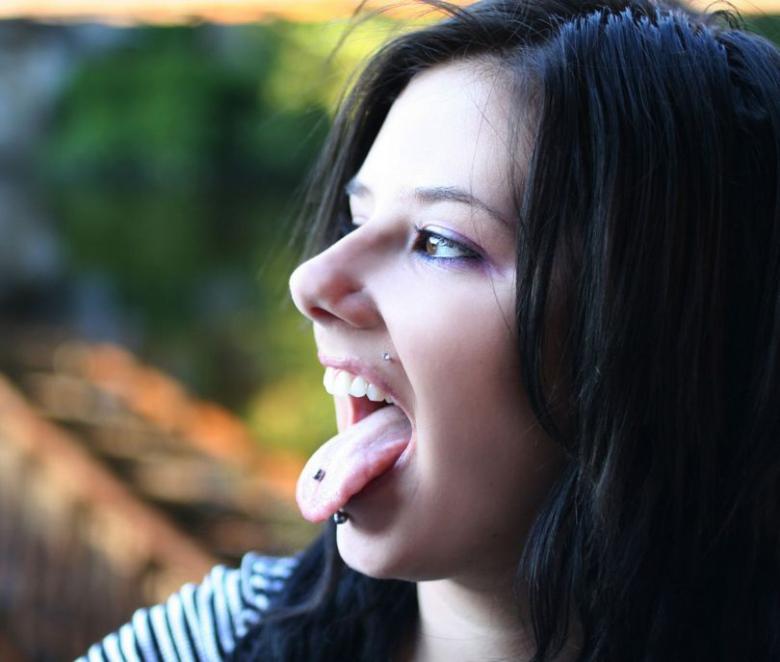

It is worth avoiding tongue studs and earrings made of plastic and wood. Despite their very low price, they can contribute to the development of infectious complications and allergic reactions.
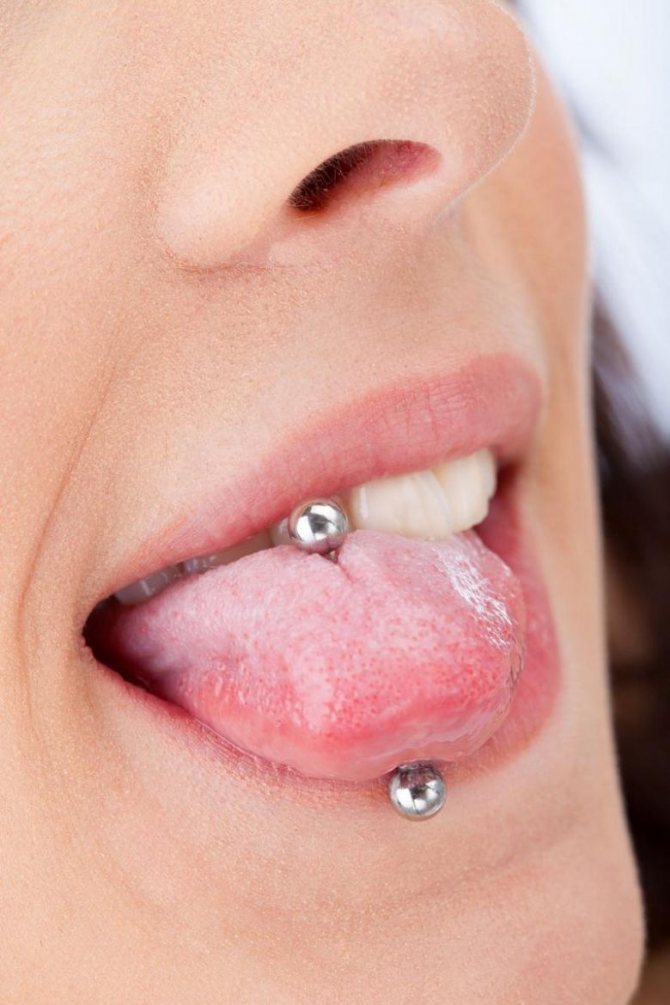

The recovery period
The most painful and unpleasant sensations occur during the recovery period. Until the wound surface has healed, the person must observe strict restrictions.
In the first 24 hours after surgery, the surface of the tongue is very sore and swollen. These changes are normal, the pain is the result of trauma to the soft tissues and the swelling is the cause of damage to the lymphatics and blood vessels. The swelling can last for several days.
The wound heals within 2-3 weeks. Complete healing of the wound surface occurs 3-4 months after surgery.
In the first weeks after surgery you should be anxious about your diet. It is important to exclude all spicy, smoked and salty foods from the menu. Meals should not be hot. It is optimal to use liquid, fresh, warm food.
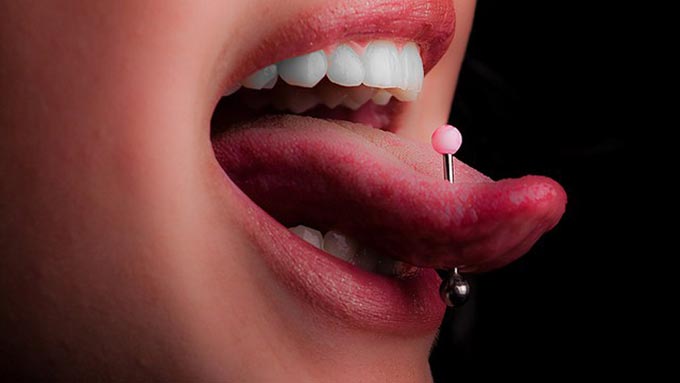

Care of a pierced tongue
The basis of care for a pierced tongue is the treatment of the soft tissues. Every day, twice a day, the wound should be treated with antiseptic solutions (chlorhexidine, baking soda or manganese solution).
For the first 2 weeks after surgery you need to rinse your mouth after eating. The first few days you rinse with antiseptic solutions (Chlorhexidine). Later you can rinse your mouth with decoctions of medicinal herbs (chamomile, sage, calendula).
Care for the rod
Within 2 weeks after the piercing of the tongue, it is required to brush the rod daily with a toothbrush. After this time, it is necessary to regularly remove "jewelry" to thoroughly clean it from surface contamination and disinfect it in a solution of Chlorhexidine.
Choice of rod
Tongue piercing rod, is a tool for piercing, which consists of a metal rod with an average width of 1.6 mm, as well as 2 fixing screws. To choose the right earring to avoid significant complications and discomfort when wearing it, you should know about what sizes exist, materials, and be able to wear the jewelry correctly.
Size
The thickness and length of the metal product is selected based on the individual characteristics and preferences of the client. The bar of standard size is a construction with a length of 16 mm and a width of 8 mm. The diameter of the twist, - the outer ball or stone, is also taken into account. In the case of using a standard rod, the product does not protrude beyond the upper layers of the tongue. Correctly inserted design practically does not move out and does not lead to deformation of tissue structures.
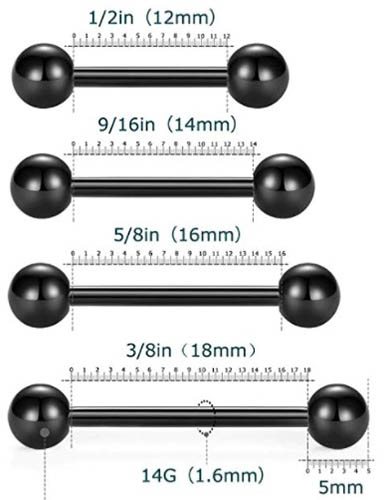

Tongue piercing bars
The client can choose any suitable size - from 5 mm to 40 mm, depending on preferences. Specialists recommend inserting standard rods into the tongue, which will not cause any discomfort.
The larger the diameter of the item, the more you will need to stretch the puncture point. Too large jewelry is characterized by great discomfort when wearing it, so it is more difficult to get used to it. Rings or bars that touch the surface of the teeth can lead to rapid degradation of enamel.
Thin bars are not recommended, as they are more likely to be displaced, which can provoke a strong stretching of the piercing - in some cases to the size of an ear tunnel.
Materials
To eliminate possible suppuration or irritation, special attention should be paid to the choice of material. For constant wear of the rod, experts recommend using gold or silver products, the chemical composition of which will not affect your health in any way.
Cheap metal construction, especially varnished or painted, will begin to oxidize and crack, causing the inner coating to remain inside the pierced area.
It is best to buy products made of titanium, a material widely used in medical practice. This kind of metal combines better with the external tissues of the person, so it does not lead to rejection, has no toxicity, and is absolutely harmless to the body.
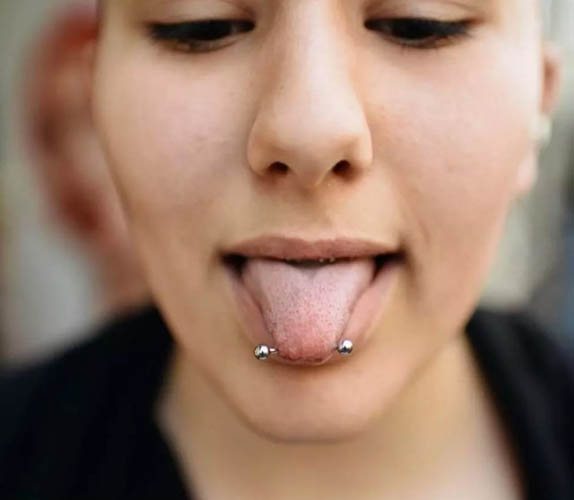

After the direct incision of tissues, it is best not to use medical metal, because the chances of developing suppuration in the tongue increase. It is better to use silver or gold inserts while the wound is healing.
Recently, booms made of silicone, surgical steel and bioplastic have been gaining popularity, each of which has its own advantages and disadvantages. In this case, it is best to consult a specialist.
Designs
Girls are best suited for small metal balls of uncomplicated shape or shiny rhinestones. Rather interesting look multicolored elements that resemble spikes.
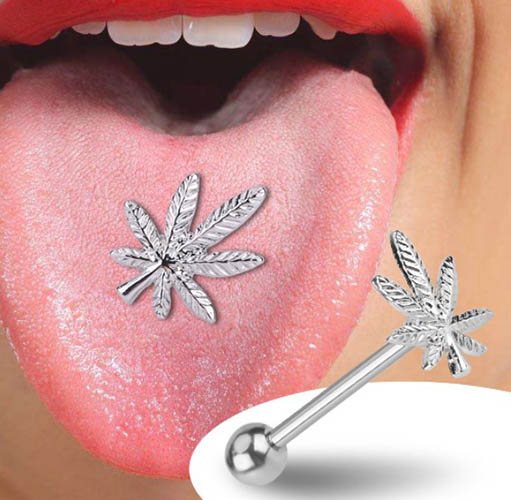

Particularly popular are shaped bars for piercing, the image on which can be as brutal - bones, skulls, crosses, and feminine, in the form of hearts, stars or butterflies. A big role is played by imagination and understanding your own preferences. Some models are characterized by a special carving, which allows you to alternate between different forms on the same rod.
Frequently used varieties of jewelry:
| Variety of decoration | Description, advantages |
| Barbell | Is the most popular and safe option. The product is a rod of a straight shape, at the ends of which there are special balls that allow you to better fix the decoration. |
| Banana | A variation of the rod, which is distinguished by its curved shape. Like the usual variation, this type of decoration also belongs to the classics. |
| Labret | The same rod, but on one end there is a molded base, and on the second, there is a special thread for screwing an additional decoration. The variation is the lightest available. |
| Ring | Represents the usual ring-shaped jewelry, on the end of which there is a special ball that fixes the product on the tongue. |
| Rod and ring | Is the most popular variety in the case of vertical piercing. |
Metal rods often have a silver color, where the exceptions are: acrylic, gold, and surgical steel, which can be found in black or gray. Cheaper models can be in different shades due to the addition of paint or varnish, but such materials can cause a wide range of complications and discomfort in the tongue.
Many experts in the field of piercing point out that when choosing jewelry, it is better to pay attention to the classic bar, which is characterized by a straight and elongated shape.
How to put on
The barbell is put on immediately after the piercing, which allows you to avoid further complications or damage while wearing it. After about 3-4 weeks, the earring can be replaced with a new item.
Even after the wound is completely healed, in the process of removing or putting on, it and the entire oral cavity should be treated with a liquid saline solution, and the jewelry itself, using hydrogen peroxide.
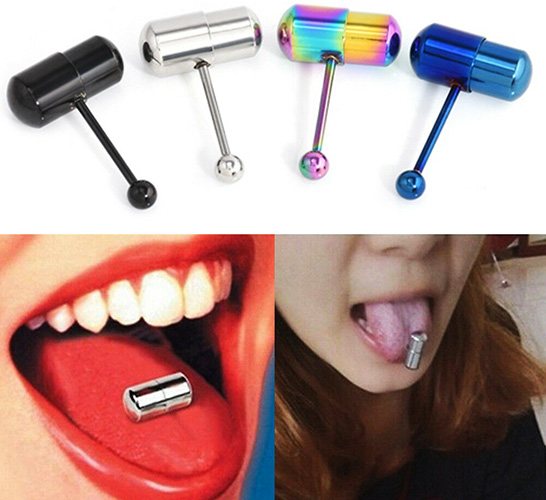

Always use caution when inserting the bar. It is better to do it from the bottom up, which will avoid many complications. In some cases, the earring may include a special clasp on which the balls are attached. Such a model is quite difficult to remove, so it is best to go for advice and help to a specialist.
If there are any difficulties in the process of putting on or taking off the barbell, it is necessary to contact a master piercer. Otherwise, the place of the piercing can tear, which significantly increases the risk of inflammatory or purulent process in the mucous tissues of the oral cavity.
Possible complications
If the operation was performed poorly, the tongue after the piercing will be very painful. On the surface of the soft tissues will begin to develop signs of an inflammatory process (redness, severe swelling, itching). The wound surface will heal slowly.
Complications after piercing:
- severe bleeding;
- Infection of the wound surface;
- pain when eating, swallowing or communicating.
If negative effects develop, an emergency visit to a doctor is necessary. Treatment of the inflammatory process consists of treatment of the wound surface with antibacterial and anti-inflammatory solutions. The doctor may also prescribe antibacterial injections.
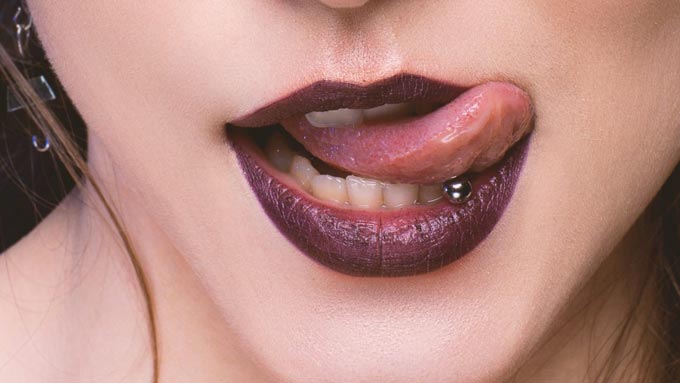

How to reduce the healing time
- Keep the swelling down. Drink ice-cold drinks, preferably water.
- Keep it clean. This includes cleaning not only the piercing site, but the entire mouth. Brush at least twice a day. Rinse and gargle after every meal, after drinking anything but water, when you first wake up, and before going to bed. Use non-alcoholic and fluoride-free antibacterial mouthwash or a glass of water with a teaspoon of sea salt (not from iodized table salt!) dissolved in it.
- Wear the right jewelry. Make sure the dumbbells are held tightly by the lower ball while you twist the upper ball clockwise. After the initial swelling decreases, your piercer change more of the bar to a shorter one. After that, you don't want to change your jewelry too often, which can irritate the site and prolong the healing. Titanium is the least likely material to provoke an allergic reaction.
- Avoid irritants. Do not put your fingers in your mouth. Don't touch, poke, or fumble with jewelry. If you talk or chew a lot, rinse your mouth afterward. Do not drink alcohol, smoke, kiss or expose your mouth to anything other than food, drinks, mouthwash, toothpaste, salt and water.
- Watch for signs of infection. Of course, delaying an infection is healing, so if you observe swelling, redness, angry-red streaks, discoloration or discharge, see your doctor right away.
Contraindications
Piercing is quite popular these days. But tongue piercing is not available to everyone. Before you decide to undergo surgery and go to the master, it is necessary to study the list of contraindications:
- Allergy to antibiotics;
- Pregnancy (the risk of developing an infection poses a serious threat to the future mother and the baby);
- allergies to metals;
- diseases of the nervous system;
- Poor blood clotting;
- diseases of the oral cavity;
- epilepsy;
- some autoimmune diseases (diabetes, hemophilia).
Tongue piercing is a modern procedure that helps a person stand out among the "crowd". But before deciding to have a piercing, it is necessary to assess all the disadvantages, consequences and dangers of the difficult operation.
Sources used:
- Harden, Blaine. Coming to Grips With the Enduring Appeal of Body Piercing, The New York Times
- A. Stirn (2003): Body piercing: medical consequences and psychological motivations, The Lancet
- Wikipedia material
